Rock art is one of the oldest legacies of humankind. One could argue that rock art is the basis of a writing system, conveying cultural messages, beliefs and myths. In Iran, rock art sites have been discovered in Birjand (Lakh mazar), Khorasan (Nehbandan), Yazd (Arnan), Sistan and Baluchistan (Nikshahr and Saravan), Isfahan (Gharghab and Kucherey in Golpaygan and Vist in Khansar), Lorestan (Homiyan in Kuhdasht, Khommeh in Aligudars, Mihad in Boruherd), Arak (Ibrahim Abad, Yasavel in Komijan, Ahmadabad in Khondab and Khomein), Hamadan (Darre Shahrestaneh Alvand, Darreh Ganjnameh, Mehrabad and Khoshijan in Malayer), Aras baran) Kurdistan (Dehgolan and Saral), Tehran (Dowlatabad village, Sharyar, Kuhe (Kaftarlu) and Qum (Kahak). In the region of Khomein, there are many thousands of rock art sites, some of which have been dated to approximately 4,000 years old.
The Ibex Motif
Almost 90 percent of Iran’s rock art consists of the ibex motif. The ibex for the prehistoric inhabitants of what is now known as Iran appears to have received the same apotheosis as the eland for the San in what is now known as South Africa. The ibex would have been a source of meat and secondary products such as horn and hide. Archaeological evidence shows that it was hunted in Iran from the Middle Paleolithic period onwards, at the Warwasi and Yāfte Cave (ca. 38,000-29,000 B.C.E.) sites where it was the dominant species represented. Studies of horn cores from the early Neolithic sites of Tappe ʿAli Koš and Tappe Sabz indicate that ibex were being hunted in the late 8th and 7th millennia B.C.E.
The ibex motif went on to be incorporated into decorative friezes on painted pottery in pre-Islamic Iran. The elegantly stylized ibex appears as a decorative motif on Chalcolithic pottery – in Luristan at Čeḡā Sabz, Se Gābi and Tappe Giān – with long, curving horns and characteristic beard. Long-horned caprids, many of whom may be ibex, appear on pre-Islamic stamp and cylinder seals all over Iran. An ibex-headed figure – possibly a human wearing the horns of an ibex – appears in the guise of the ‘master of animals’ on stamp seal impressions from Susa dating to ca. 4000 B.C.E. Middle Elamite, Neo-Assyrian, provincial Neo-Assyrian, and Neo-Elamite cylinder seals from Čeḡā Sabz and Sorḵ Dom-e Lori in Luristan illustrate hunters with bow and arrow shooting leaping caprids.
The symbolic and/or religious significance of the ibex in pre-Islamic Iran is unclear, although some argue that it was integral to a pre-Islamic creation narrative. According to the Zoroastrian – ‘Zarathusti’ in Persian – cosmogony, ‘Mashya and Mashyana’, or ‘mašyā and mašyānē’, were the first man and woman whose procreation gave rise to the human race. According to Mohammad Naserifard [pictured], it was the ibex that was chosen as the symbol of divine assistance. With the ibex carvings in the rock art sites of ancient Persia, this may have represented an over-riding belief in, and request for, the provision of water, the guarantee of fertility and birth, and a Divine – ‘hu’ – blessing and protection.
Iranian Rock Art by Dr Mohammad Naserifard


